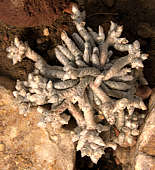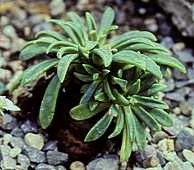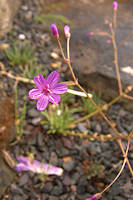Portulacaceae Jussieu 1789
The Portulacaceae includes around 450 species of leaf succulents, herbs and shrubs in 12 genera including Avonia, Anacampseros, and Portulaca (Purslanes). The Portulacaceae is the closest family to the Cactaceae, and the two families may share a common ancestor.
The Portulacaceae are widely distributed with the highest concentration of species in arid areas of the Southern hemisphere.
Recent revisions based on molecular data move the African genus Portulacaria from the Family Portulacaceae to the Family Didiereaceae: further revision expanded Portulacaria by moving members of the genus Ceraria into it and renaming them.
|
Anacampseros Linnaeus 1758
The genus Anacampseros was recently (Rowley, 1994) split into Anacampseros and Avonia from South Africa, and Grahamia from the Americas and Australia. Many plant labels and plant nurseries have not yet caught up with this change, so all these plants may still be seen labelled as Anacampseros.
Anacampseros (Linnaeus 1758) is a genus of dwarf succulent plants with rosettes of rounded or lanceolate, fleshy leaves. The stem may become caudiciform with age. Leaves and stem may be hairy, in some cases with very prominent white filamentous hairs.
The small pink to white flowers typically open for about an hour during the late afternoon of sunnt days, so many people miss their opening and believe that these plants set seed without opening their flowers. However, at the right time of day a window-ledge of Anacamseros can be rewarding. The flowers are self fertile and appear to not hybridise, even in a mixed collection.
Avonia (Linnaeus, 1758) is reserved for the species with tiny leaves hidden by papery stipules which form a protective layer along the stems. These bright white scales reflect a proportion of the solar radiation and protect the leaves from the noon-day sun. The small, solitary flowers are greenish-white and produced on the tips of the stems. The roots form a small caudex.
Grahamia (Gillies ex Hooker & Arnott 1833) are from Latin America and Australia. Several species have tuberous roots.
Cultivation: Avonia and Anacampseros grow well at moderate to cooler temperatures in partial sun. Bright light enhances leaf colours and makes for a compact plant. They enjoy a gritty free-draining soil with added organic material and low to moderate watering depending on the species. A collection of these plants can be housed in quite a small space.
The choice caudiciform species are prone to taking a sudden dislike to life and should be watered very sparingly. The botanical name commemorates an ancient belief in herbs that restore lost love.
|

|
Anacampseros albidiflora Poellnitz 1929
Native to the Western Cape of South Africa.
|

|
Avonia albissima (Marloth) G.D.Rowley Syn. Anacampseros albissima Marloth 1912
Native to the Northern Cape of South Africa and Namibia.
|

|
Anacampseros crinita Dinter 1928
Native to the Northern Cape Province, Namaqualand.
|

|
Anacampseros rufescens Sweet 1826 Syn. Anacampseros arachnoides
This small succulent plant has tuberous roots and dichotomously-branched stems bearing spiraling rosettes of succulent reddish-green obovate leaves. White hairs are produced from the leaf axils to a variable extent. The long flower stems produce bright pink flowers.
Native to the Eastern Cape, Free State, KwaZulu-Natal and Lesotho.
|
|
For Ceraria see Family Didiereaceae: Portulacaria
|
Lewisia Pursh 1814 (Bitterroot)
named for: Captain Meriwether Lewis 1774-1809

is a semi-succulent genus of around 20 species native to North America, popular with alpine growers for its bright, showy flowers. Species of interest to growers of succulent plants, have tuberous taproots and fleshy leaves. The fleshy roots of some species of Lewisia were valued as a staple food by American Indians. Dried roots were traded for other items.
Cultivation: Lewisias like very well-drained, low fertility, acidic to neutral soils in sunny positions in rock gardens, scree beds or containers. With the constant wet of the English Winter (and some Summers) Lewisias are probably best kept in a well-aired cold frame. Air humidity should be low with good air circulation around the crown to prevent attack by fungi. Under such conditions they can be watered freely from below during the growing season, but keep water off the sensitive crown of the plant. Species with a dormant period should be kept drier while out of leaf.
|

|

|
Lewisia columbiana (Howell ex A. Gray) B.L. Robinson 1897 (Columbian Bitterroot)
is a succulent alpine with fleshy leaves and a small fleshy taproot, native to Washington and British Columbia to Oregon, Idaho and California. A panicle of small white to magenta flowers is carried on a thin stem. The petals often have longitudinal stripes. The bitter tuberous root was collected for food or to trade by American Indians.
Plant the crown of the plant well above the surface of the soil, higher than it would be in its habitat, and mulch around with gravel.
|

|
Lewisia congdonii (Rydb.) S. Clay1937 (Congdon's Bitterroot)
has a very limited distribution at elevations up to about 5000 ft in the Sierra Nevada of California including Yosemite National Park. The deciduous rosette is composed of soft but slightly fleshy leaves growing from a thick tap root. Clusters of small pink and white striped flowers are produced on long stems.
|

|
Lewisia cotyledon (S. Watson) B.L. Robinson 1897 (Siskiyou Bitterroot)
is a popular succulent plant with alpine growers because of the spectacular array of flower colours from white and yellows to reds, often with striped petals. It is native to Northern California and Oregon where the wild plants have pink and white striped flowers. The evergreen rosettes of dark-green leaves are only slightly succulent, but the tap root is thick and fleshy.
In cultivation, plant the crown of the plant above the surface of the soil and mulch around it with gravel. Water from below and avoid getting water in the crown. Numerous hybrids and cultivars are available with specific flower colours. They are lime-intolerant.
|

|

|
Lewisia leeana (Porter) B.L. Robinson 1897 (Quill-leaf Lewisia, Lee's Bitter-root)
Named for: Lambert Wilmer Lee who collected it in the Siskiyou Mountains, Oregon in 1876
A small caudex with a narrow woody tap-root produces a basal rosette of fleshy, flattened-cylindrical leaves with rounded tips. The long, branching inflorescence bears many pinkish flowers with 5 - 8 petals.
Native to mountains in Northern California into Southern Oregon. Associated with serpentine soil. Hybridises with Lewisia cotyledon where the ranges overlap to produce the natural hydrid Lewisia x whiteae.
|

|
Lewisia pygmaea (A. Gray) B.L. Robinson 1897 (Pygmy Bitterroot, Alpine Lewisia)
is a low-growing alpine with narrow, succulent leaves and a small fleshy taproot, native to elevations of 9000 - 15000 ft across the Western USA from Alaska to Arizona. A variable species across its range and hybridizes freely with other species e.g. L. nevadensis. The flower stem is produced close to the ground and carries a cluster of small white flowers veined with pink and with a greenish throat.
Plant in very free-draining compost. This plant is very dry-cold hardy, but dislikes wet winters. A good subject for a cold frame where moisture can be kept off the crown.
The bitter, tuberous root is edible, but eating it (regularly?) was believed by some Indian tribes to cause insanity. On the other hand, it was regarded as a good luck charm for gambling.
|
 |
Lewisia rediviva Pursh 1813 (Bitterroot)
is native to a wide range of North America from Montana and Alberta to Southern California and Arizona, typically growing on free-draining soils on lower mountain slopes. The tuberous taproot supports clusters of long, rounded leaves which are quite fleshy, making this plant one of the more succulent Lewisias. Flowers are produced in early Summer and may be white to quite a deep pink. Flowers are followed by oval seed capsules containing many seeds. The plant then dies down and remains dormant until the following Spring rains.
|
Bitterroot plants are sensitive to crown rot, so always water from below and provide a layer of gravelly top-dressing around the crown. Watering should be sensitive to the growth phase of the plant.
The fleshy taproot was collected for food and for medicinal use by American Indians, forming an important part of the diet. The dried roots were traded and provided subsistence food for the Winter. L. rediviva is the state flower of Montana.
|

|
Lewisia tweedyi (A. Gray) B.L. Robinson 1897 (Tweedy's Bitterroot)
named for: railway topographic engineer Frank Tweedy (1854-1937)
This Lewisia from the Wenatchee Mountain range in Washington and British Columbia produces one to three large apricot flowers on each flower stem. Flowers are occasionally flushed with pink and white forms are also known. The slightly-upright, evergreen rosette is formed from wide, pointed, succulent leaves up to 8in long, marked with veins diverging from the leaf base.
The compost should be exceptionally free-draining and water kept off the crown.
|
|
For Portulacaria afra see Family Didiereaceae: Portulacaria
|
Portulaca Linnaeus 1753 (Purslanes)
is the type genus of the Family Portulacaceae. The Purslanes are mostly weedy plants but Portulaca grandiflora (Moss Rose) is often used for annual summer bedding. Selected cultivars are available in bright pinks and yellow and with double flowers.
|

Big Bend National Park, Texas.
|

South of Shafter, Texas.
|
Portulaca pilosa Linnaeus 1753 (Shaggy Portulaca)
Latin: pilos = covered with long soft hairs
is a common annual weedy succulent plant on stony ground in the South-Western USA. The tiny pink flowers in the middle of a tuft of white hairs at the end of stems are easily overlooked.
Portulaca pilosa is widely distributed through the tropics including the Americas, Asia and many tropical islands.
|





















